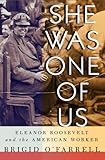ER: She Wore the Union Label; A Review of She Was One of Us
by Jo Freeman

She Was One of Us: Eleanor Roosevelt and the American Worker
by Brigid O'Farrell
Cornell University Press
Cloth, ©2010; 304 pages
Eleanor Roosevelt (ER) was a chameleon. A child of wealth and privilege, she had a talent for getting people with whom she had little in common to believe that "she was one of us." During her twelve years as first lady, members of the working class — black and white together — believed that they had a friend in the White House.
Born in 1884, ER was raised by her maternal grandmother. She inherited her progressive views from her Uncle Teddy, who became President when she was 17, and her independence from the feminist headmistress at the finishing school she attended in London, who taught her to think for herself. She spent her debutante years volunteering at a settlement house on the lower east side of Manhattan, while being courted by her fifth cousin, once removed.
Franklin Delano Roosevelt got his initial exposure to the problems of ordinary workers through ER and this continued after he became President. Women trade unionists that ER met through the Women’s Trade Union League were invited to their homes in Manhattan and upstate New York, and later to the White House. During her travels, when ER heard stories of employer atrocities that she thought the federal government could respond to, she passed the information on to her husband.
However, it’s what she did on her own, not just as a conduit to FDR, that made her loved by the workers. ER walked on picket lines, went into mines to inspect working conditions, visited migrant camps and testified before Congress about what she saw. She also wrote.
On December 31, 1935, ER published her first syndicated newspaper column. Called "My Day," it appeared six days a week and reached over four million readers of many different newspapers daily. A year later, she joined a new labor union, the American Newspaper Guild, which was affiliated with the CIO — the Congress of Industrial Organizations. ER used her column to talk about workers’ problems, the need for unions, and also to speak to union leaders. Even during wartime she spoke for the right of all workers to join unions.
ER’s outspoken support gave labor unions what political scientists call "elite legitimation." Labor unions had been around for a long time but only during FDR’s administration did they acquire mainstream respectability. To this, the first lady made a major contribution.
Pages: 1 · 2
More Articles
- Jo Freeman Writes: Kennedy vs. Trump at the Libertarian National Convention
- National Archives Records Lay Foundation for Killers of the Flower Moon: The Osage Murders and the Birth of the FBI
- Nichola D. Gutgold - The Most Private Roosevelt Makes a Significant Public Contribution: Ethel Carow Roosevelt Derby
- Oppenheimer: July 28 UC Berkeley Panel Discussion Focuses On The Man Behind The Movie
- Selective Exposure and Partisan Echo Chambers in Television News Consumption: Innovative Use of Data Yields Unprecedented Insights
- Jo Freeman Reviews Thank You For Your Servitude: Donald Trump's Washington and the Price of Submission
- "Henry Ford Innovation Nation", a Favorite Television Show
- Jo Freeman Reviews Formidable: American Women and the Fight for Equality
- Julia Sneden Wrote: Going Forth On the Fourth After Strict Blackout Conditions and Requisitioned Gunpowder Had Been the Law
- Jo Freeman Reviews: Gendered Citizenship: The Original Conflict Over the Equal Rights Amendment, 1920 – 1963






